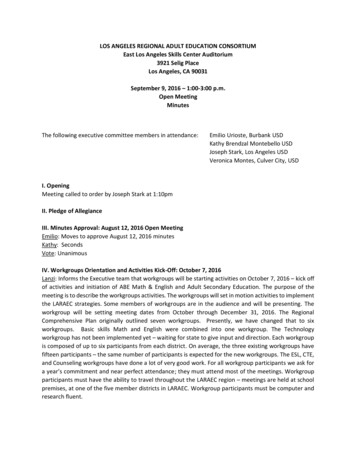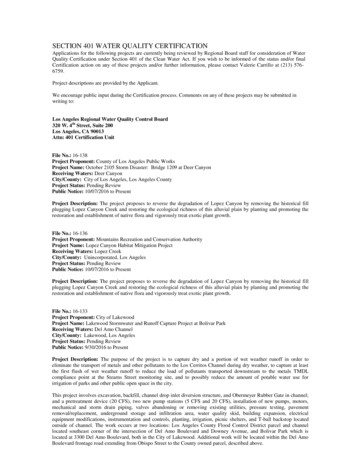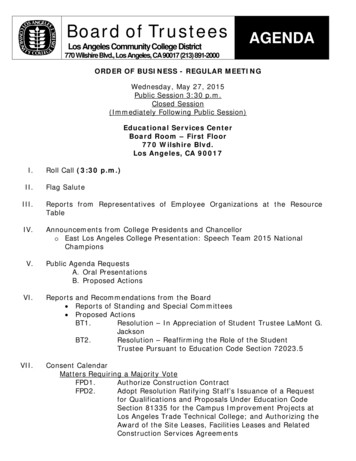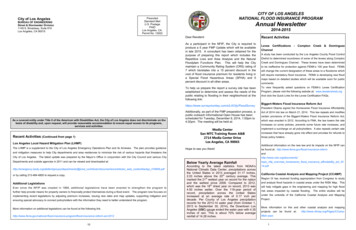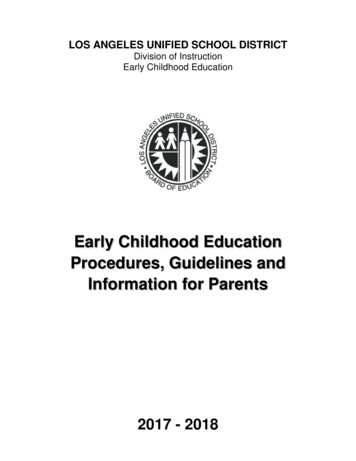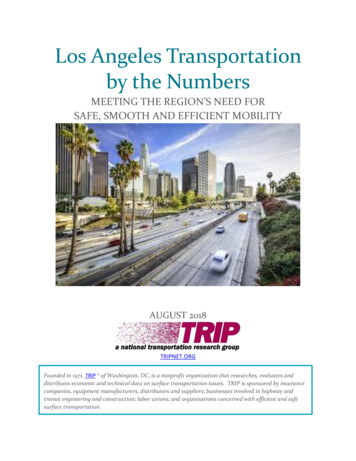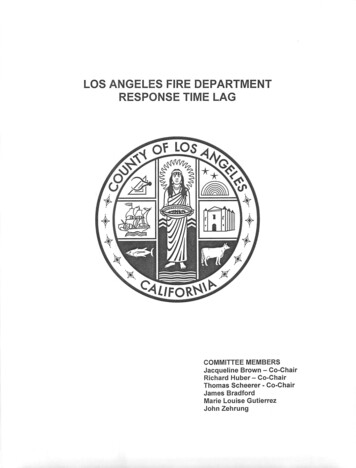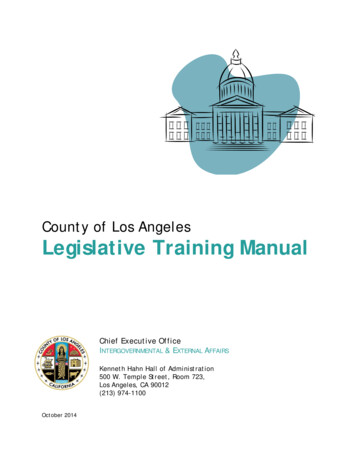
Transcription
County of Los AngelesLegislative Training ManualChief Executive OfficeINTERGOVERNMENTAL & EXTERNAL AFFAIRSKenneth Hahn Hall of Administration500 W. Temple Street, Room 723,Los Angeles, CA 90012(213) 974-1100October 2014
TABLE OF CONTENTSTable of Contents . 1Legislative Program Overview . 2Development and Implementation of the County’s Legislative Program . 3The State Legislative Process . 6State Legislative Bill Analysis . 10Reading a Bill to Identify Key Information . 11Bill Text . 12Identifying Legislative Intent . 13Identify All Requirements, Prohibition, or Permission Statements. 13Identifying Changes to Existing Law . 13Understanding a Bill’s Context . 14Estimating Potential Impact to the County . 14Developing Recommendations for a Board Position . 15Bill Analysis Format. 16The Federal Legislative Process . 17Appendix . 18Los Angeles County Table of Contents1
LEGISLATIVE PROGRAM OVERVIEWThe Intergovernmental and External Affairs Branch of the Los Angeles County Chief ExecutiveOffice (CEO-IGEA) is the focal point for coordination of legislative policy and strategy for theCounty. In consultation with the Board of Supervisors, the County’s Legislative Strategist, andCounty departments, CEO-IGEA develops the County's legislative priorities and policiesannually for consideration by the Board, and analyzes legislative proposals throughout the year.The County's advocacy is handled on a day-to-day basis by the Sacramento and Washington,D.C. offices.This legislative training manual is designed to help you: Learn how the County’s State and Federal legislative programs are developed andimplemented; Understand the State and Federal legislative processes; Understand your department’s role in informing, developing, and revising theCounty’s legislative agendas; Analyze proposed legislation to determine its potential impact to the County; and Prepare bill analysis documents to recommend County advocacy positions onproposed legislation.Legislation plays a significant role in determining State and Federal policies, regulations,programs, and funding allocations that affect the County’s operations and budget. For example,enacted legislation may: Change governmental roles or functions; Change the governance of a department or program; Change the level of resources available (e.g., revise the way the County isreimbursed for its services); Place restrictions on departmental activities; Change conditions of operation (e.g., reduce or expand the caseload of a Countyservice worker); Require additional work procedures (e.g., require additional reports); or Indirectly impact County department by affecting clientele or other related agencies(e.g., services provided to the public or additional requirements for contract agenciesthat raise cost).2 Legislative Program Overview Los Angeles County
DEVELOPMENT AND IMPLEMENTATIONLEGISLATIVE PROGRAMOFTHECOUNTY’SThe dynamics of the State and Federal legislative processes require the County to beresponsive to changing circumstances and new concerns. It is important that the County has anongoing, timely process to bring new information about legislation or policy to the Board’sattention. By establishing Board adopted legislative goals and policies, the County’s advocatesin Sacramento and Washington D.C. can effectively respond to legislative proposals that couldsignificantly impact on the County’s finances and/or programs.Information on specific legislative policies and goals may be viewed in Chapter 7 of the Board ofSupervisors Policy Manual. This document contains copies of the most recent version of theFederal and State policies and goals adopted by the Board. An electronic version of the Boardof Supervisor’s Policy Manual can be viewed at:http://countypolicy.co.la.ca.usThe following sections describe how the County establishes its legislative agendas, and updatesthem during the legislative session.Development of the Annual Legislative AgendasEach year, the County’s State and Federal Legislative Agendas are developed based on ananalysis of the political and economic climates in Sacramento and Washington, D.C. Thelegislative agendas outline the County’s objectives and policies in this context, and provide aframework for ongoing advocacy throughout the year. These documents are usually adopted bythe Board in December or January, and constitute the cornerstone of the County’s legislativeprogram.Every year, prior to presentation to the Board for consideration, County departments are askedto submit their policy recommendations and requests for County positions on issues and goalsto CEO-IGEA. Recommendations are also obtained from Board offices, the County’s legislativerepresentatives, and the County’s Legislative Strategist, as well as from task forces, workinggroups, commissions and advisory bodies. The State and Federal Agendas include some of thefollowing general principles and positions:General Principles Maximize revenues from State and Federal sources. Secure greater flexibility over the use of State and Federal funds. Lessen any adverse impact of State or Federal policies on County finances anddecision-making authority.General PositionsLos Angeles County Development and Implementation of the County’s Legislative Program3
Support proposals which would provide a greater share of total available programfunding to the County or California, and oppose proposals which would reducethe County’s or State’s share of available funding. Support proposals that provide local governments with greater decision-makingauthority over the use of State or Federal funds. Oppose proposals that would impose new unfunded mandates on the County. Give priority to increasing or preserving funding for programs and activities thatensure equitable treatment of the County and/or California. Oppose proposals which would finance increased spending for one program bycutting other programs of greater benefit to the County, or which would result in anet revenue loss or cost shift to the County or they State.The most current State and Federal Legislative Agendas can be found at the CEOIntergovernmental and External Affairs web page: http://ceo.lacounty.gov/igr/leg info.htmBoard Motions, Legislative Update Memos, and Board LettersWhile the Board adopts State and Federal legislative agendas each year, the County’slegislative policy development is an ongoing process. As part of the normal legislative cycle, theCounty takes positions on specific bills and proposals within the general framework outlined inthe Board adopted legislative agendas. These positions are typically developed in two ways,Board Motions or Legislative Update Memos issued by the CEO.Additionally, issues may arise during the year for which the County has no adopted legislativepolicies, or there may be a need to amplify or refine existing policies. In these cases, BoardMotions and Board Letters developed by the CEO are the most common vehicles used for theBoard to consider adoption of these policies. Board Motions. Members of the Board of Supervisors may initiate a motion forconsideration by the full Board concerning a particular bill or a policy matter. In theseinstances, CEO-IGEA coordinates the CEO’s response to the Board through an AgendaMemo that includes an analysis and recommendation on the substance of the Boardmotion. The CEO’s analysis reflects recommendations from affected departments and,as necessary, County Counsel. The CEO’s recommendations are made in the contextof the Board’s existing legislative policies.Example of a Board Motion: http://file.lacounty.gov/bos/supdocs/68767.pdfThe related Agenda memo: http://file.lacounty.gov/bos/supdocs/68924.pdf Legislative Update Memo. The CEO regularly communicates to the Board onlegislative matters through Legislative Update Memos (commonly referred to asSacramento Updates or Washington, D.C. Updates). These memos are developed by4 Development and Implementation of the County’s Legislative Program Los Angeles County
CEO-IGEA, and are used to inform the Board when the County is pursuing a position ona bill consistent with Board-adopted policies or to provide a status update on Countyadvocacy legislation. Legislative update memos are also used to inform the Board aboutmatters of significant interest to the County such as State or Federal budget items,upcoming legislative hearings, or a synopsis of the hearing testimony.Electronic copies of State and Federal Legislative Update Memos are accessible on theCounty’s Board Correspondence web page at: http://portal.lacounty.gov/wps/portal/bc Board Letters. In the absence of existing County policy in the State and FederalAgendas, a Board Letter is prepared by the CEO, and placed on the Board’s agenda.The Board Letter can either provide an analysis and recommendation on specificlegislation by the CEO based upon information provided by affected departments oradvisory bodies, or the Board Letter may request that the Board to adopt a new policy onmatters of importance to the County. If approved, the policies are added to the County’sexisting legislative policies.Analysis and Monitoring of LegislationAnalysis and monitoring of proposals in Sacramento and Washington, D.C. is and ongoingprocess, and central to the efficacy of the County’s legislative program. Whenever the Boardhas adopted a policy on an issue, or has taken a position on a bill, the CEO-IGEA and affecteddepartments are responsible for monitoring legislation pertaining to those issues. CEO-IGEAprepares a report entitled, “Status of Bills of Interest to the County,” which is updated on aregular basis and contains information on all current legislation on which the County has taken aposition. The current version of this report can be accessed on the CEO-IGEA website via thefollowing link: http://ceo.lacounty.gov/igr/PDF/bill list/2012/current.pdfCEO-IGEA staff relies on many sources to gather information about legislative, budget andpolicy proposals throughout the year, including the County advocates in Sacramento andWashington, D.C., budget analysts in the CEO’s office, and legislative analysts in Countydepartments. Departmental staff is responsible for providing information about how bills willimpact departmental operations, technical advice, and other policy related information to theCEO-IGEA staff throughout the legislative process.Consequently, it is important fordepartmental legislative analysts to be in contact with their CEO-IGEA analyst throughout theyear. Professional associations such as the California State Association of Counties (CSAC),the Urban Counties Caucus (UCC), and the National Association of Counties (NACo) alsoprovide valuable information and bill tracking resources that can be incorporated into theanalysis and monitoring of legislation.Advocacy is the responsibility of our Sacramento and Washington, D.C. offices.A current roster of the CEO-IGEA analysts and their Departmental assignments can obtained bycalling the CEO-IGEA office at (213) 974-1100.Note: An in-depth discussion of how to analyze legislation can be found starting on page 11.Los Angeles County Development and Implementation of the County’s Legislative Program5
Coordination of County Legislative Positions in Sacramento and WashingtonBoard Policy number 7.030, established on March 30, 1995, provides that the County’s positionto be advanced before the State Legislature or the United States Congress by Countyrepresentatives must be coordinated in order to ensure a consistent and harmoniouspresentation. It also establishes uniformity in the manner that positions will be advanced. ThisBoard Policy can be accessed at: http://countypolicy.co.la.ca.us/7.030f.htmCEO-IGEA is the focal point for coordination of legislative policy and strategy for the County.Designated advocates and officials represent the County’s interests in Sacramento andWashington, D.C. To ensure coordination, it is important that County officials advise the Boardand CEO-IGEA in advance of plans to attend meetings and hearings in Sacramento orWashington, D.C., using the form the County Travel Report form (Appendix #8). Please contactLisette Morikawa in the CEO’s office at (213) 974-1700 for more information.THE STATE LEGISLATIVE PROCESSInformation in this section has been adapted from the booklet entitled “Legislative Procedure,” apublication of the Office of the Assembly Chief Clerk. A full copy of the booklet, which also containsuseful information on legislative rules and floor procedures, can be downloaded from the following LATURE/Leg Procedure.pdfThe Office of the Assembly Chief Clerk’s website also provides links to other informative publicationsrelated to the State legislative process, such as a guide to legislative research and a glossary oflegislative terms. Those links can be found on the following LATURE/LEGPROCESS.HTMDIAGRAM COURTESY OF CALIFORNIA STATE PARKS, STATE CAPITOL MUSEUM6 The State Legislative Process Los Angeles County
The California Legislature is made up of two houses: the Senate and the Assembly. There are40 Senators and 80 Assembly Members representing the people of the State of California. Thelegislative calendar sets the deadlines for the introduction and processing of the legislativemeasures during its two-year regular session.Idea and Bill IntroductionAll legislation begins as an idea or concept and can come from a variety of sources, includingthe County. The process begins when a Senator or Assembly Member decides or agrees toauthor a bill. The legislator sends the idea for the bill to the Office of the Legislative Counsel tohave the specific language of the proposal put in proper bill form. The Legislative Counsel’s staffwill draft the language of the code section amendments to accomplish the author’s purpose.The staff attorney will also write the Legislative Counsel’s Digest for the bill, which includes asummary of the current law and what the proposed changes will do. At the end of the digest,Counsel will indicate the vote required for passage of the bill (usually “majority” or “two-thirds”),whether the bill must be referred to the fiscal committees, and whether the bill contains a Statemandated local program.The draft of the bill is returned to the legislator for introduction. If the author is a Senator, the billis introduced in the Senate. If the author is an Assembly Member, the bill is introduced in theAssembly.A bill is introduced or read the first time when the bill number, the name of the author, and thedescriptive title of the bill is read on the floor of the house. The bill is then sent to the Office ofState Publishing. No bill, except the Budget Bill, may be acted upon until 30 days have passedfrom the date of its introduction.Committee HearingsAfter introduction, a bill goes to the Rules Committee of the house, where it is assigned to theappropriate policy committee for its first hearing. Bills are assigned to policy committeesaccording to subject area. For example, a Senate Bill dealing with health care facilities wouldfirst be assigned to the Senate Health and Human Services Committee for policy review. Billsthat require the expenditure of funds must also be heard in the fiscal committees, SenateAppropriations and Assembly Appropriations.During the committee hearing, the author presents the bill to the committee, and testimony maybe heard in support of or in opposition to the bill. The committee then votes on whether to passthe bill out of committee, propose amendments to the bill, or recommend that the author’samendments be adopted by the house. Bills may be amended several times before passing outof a committee. It takes a majority vote of the committee membership for a bill to be passedand sent to the next committee, or to the floor.Prior to a bill's hearing, a bill analysis is prepared by committee staff that explains the intendedeffect of the bill on current law, estimates fiscal impact of the bill, provides backgroundinformation on similar or previous legislation on the subject matter, suggested or proposedamendments to be considered, and (if applicable) vote counts in previous committee hearings.Los Angeles County The State Legislative Process7
The bill analysis also typically lists the bill’s sponsor (if applicable), as well as organizations thatsupport or oppose the bill.Second and Third ReadingBills passed by committees are read a second time, corrected or amended, and then moved tothe third reading file. The third reading file lists all the bills that are ready to be taken up forFloor debate and final vote. Bill analyses are also prepared prior to third reading. After a bill isread the third time on the floor of the house, it is explained by the author, discussed by theMembers, and voted on by a roll-call vote.Most bills generally require a simple majority vote (21 “yes” votes in the Senate or 41” yes”votes in the Assembly) for passage. Constitutional amendments, bond measures, and billsincluding an appropriation or an urgency clause require a two-thirds vote (27 “yes” votes in theSenate or 54 “yes” votes in the Assembly) to be passed. If a bill is defeated, the Member mayseek reconsideration, amend the bill, and request another vote. A motion to reconsider is aparliamentary procedure which, if adopted, allows the bill to be heard again and voted upon at alater time.Repeat Process in Other HouseOnce the house of origin has approved the bill, it proceeds to the other house where theprocedure described above is repeated.Conference Committee – Resolution of DifferencesIf a bill is amended in the second house, it must go back to the house of origin for concurrence(i.e., agreement) on those amendments. If the house of origin does not concur in thoseamendments, the bill is referred to a two-house conference committee to resolve thedifferences. Three members of the committee are from the Senate and three are from theAssembly. If a compromise is reached, the bill is returned to both houses for a vote.Consideration of Bills by the GovernorIf both houses approve a bill, it is ordered to enrollment (proof-reading) and then delivered to theGovernor for consideration. The Governor can choose to sign the bill into law, allow it tobecome law without signature, or veto it. The Governor may also eliminate or reduce anyappropriation contained in the bill, while approving all other parts of the bill.The Governor has 12 days to consider legislation. Pursuant to the Constitution, any bill that isnot vetoed (returned) by the Governor after 12 days becomes a statute without the Governor’ssignature. The exception to this provision occurs at the end of each year of the legislativesession, when the Governor is allowed 30 days to consider bills passed by the adjournmentdeadline of the Legislature.8 The State Legislative Process Los Angeles County
If the Governor signs a bill, it generally becomes law January 1st of the following year afterwhich it was passed. Urgency measures take effect immediately, whereas special session billstake effect 91 days after the final adjournment of that special session.The Governor may veto a bill by returning it to the house of origin without his or her signature. Aletter explaining the Governor’s objections to the bill is printed in the Journal and File of theHouse from which the legislation originated.Overriding the Governor’s VetoesWhen legislation is vetoed by the Governor, the bill number and the accompanying vetomessage are printed in the Daily File for consideration by the House. Each vetoed bill shallremain on the File for no more than 60 calendar days from the day the bill was returned by theGovernor. After the 60-day period has expired, the Legislature can no longer override the veto.A veto override must begin in the bill’s House of origin. If two-thirds of the membership of bothHouses votes to enact the vetoed bill, it becomes law without the Governor’s signature.California LawWhen the Governor approves and signs a bill, the Secretary of State assigns it a number knownas the chapter number. These chaptered bills are statutes are the official record and law of theState. The bills are numbered consecutively in the order in which they are received, and theresulting sequence is presumed to be the order in which the Governor approved the bills.The Secretary of State’s website contains chapter lists, which are updated each time a bill ischaptered with the new date noted in parentheses ( ). The chapter list can be accessed via thefollowing web page: ornia Legislative Information WebsitePursuant to California law, the Legislative Counsel maintains information regarding matterspending before the Legislature on the internet, making this material easily available to thecitizens of the State. The web site contains information regarding active bills in the currentlegislative session as well as information on bills that occurred in previous legislative sessions,including: The text of the bill as introduced; All later versions of the bill, if amended, with amendments clearly identified (additions inblue italics; deletions in red strike through font); Detailed bill history (e.g., dates of committee hearings and votes); Vote counts for all committee hearings and floor sessions (i.e., count and by membername); and Copies of all bill analysis documents prepared by committee staffLos Angeles County The State Legislative Process9
In addition, you can also set up an account to track bills during the current legislative session.This service allows you to subscribe to bill numbers, adding them to your account and receivingemailed notices when a bill is amended, referred to committee, voted on or signed or vetoed bythe Governor. The website also has a text search function for bills and California Law.The Legislative Counsel’s “California Legislative Information” website is available rchClient.xhtmlNote: The Legislative Counsel also maintains a previous version of this web site at http://leginfo.ca.gov/index.htmlwhich has information on bills back to the 1993-1994 session and also provides both “html” and “pdf” versions of bills(with page and line numbers). The new site will provide “pdf” bill versions in a future release.STATE LEGISLATIVE BILL ANALYSISThe County CEO-IGEA staff relies on many sources to gather information about legislative,budget and policy proposals throughout the year, including the County advocates inSacramento and Washington, D.C., budget analysts in the CEO’s office, and legislative analystsin County departments. This information is the basis for ongoing monitoring of legislation andtimely reporting to the Board regarding potential impact to the County.Departmental staff is responsible for providing information about how bills will impactdepartmental operations and budget, technical advice, and other policy related information toCEO-IGEA staff throughout the legislative process.Consequently, it is important fordepartmental legislative analysts to be in contact with their CEO-IGEA analyst throughout theyear and to promptly respond to requests for updated analysis of bill amendments or newlegislation, and for recommendations for County positions on pending legislation.This section discusses how to read and analyze a bill using the following steps: Reading the bill to identify key information; Identifying the bill’s intent; Identifying the prohibition, permission, or requirement statements; Identifying changes in existing law; Understanding the bill’s context; Estimating impact; Developing recommendations.In this section, you will also find a description of the choices of possible positions on legislationyou might recommend for Board adoption as well as other considerations to address in youranalysis. The Bill Impact Assessment Checklist (Appendix 2) will assist you in completing your10 State Legislative Bill Analysis Los Angeles County
analysis. Appendix 3 provides the format for the bill analysis to be submitted to the CEO’soffice.Reading a Bill to Identify Key InformationFamiliarity with the legislative bills will help you locate key information quickly. The first page ofa bill contains the bill number, the bill’s author, the date of introduction, the date of eachamendment, including the last amendment, the added or amended code sections, the voterequirement, the bill’s fiscal implications, and whether there is any State-mandated local cost.The illustration on the next page highlights the useful information on a State bill whenconducting an analysis. An example of a bill introduced in the Assembly is provided forreference in the Appendix (#4). Bill Number. The bill number is the primary reference for a bill. It includes the house inwhich it was introduced and the sequential number assigned to it in the house of origin.You will find the bill number near the top of the page. On the left of the page it will say“Senate Bill” or “Assembly Bill”; the bill number will be listed after the text, “No.” on theright of the page. Bills are commonly referred to as “SB” or “AB” followed by the billnumber (e.g., “SB 1156” in the example). Author(s). The author of a bill can be found after the text, “Introduced by” just under thebill number section. Note, one or several lawmakers, or a committee, can author bills. Ifthere are coauthors to the bill, they are listed as “Principal coauthor(s)” below theauthor(s) who introduced the bill. Introduction and Amendment Dates. The date a bill is introduced in the house oforigin is indicated in the upper center of the first page (DATE in the illustration) rightbelow the author’s name. If a bill is amended, the date(s) of each amendment is postedon the top of the page, with the last amendment above the previous one (“AMENDED INSENATE DATE” in the illustration). This should be noted in your analysis because eachtime a bill is amended, the language changes. Reference is always made to the date ofthe amendment when describing the version and referring to its provisions. Note: Billanalyses must be completed based on the most recent version of the bill. Code Sections Affected. Under the author and introduction date information, there is areference to the sections of California law that the bill proposes to change. This sectionwill state, “An act to” and then note the code section that will be amended, added orrepealed. This information is helpful when you want to look up the current law to seehow the bill’s provisions amend existing statutes. Legislative Counsel’s Digest. The next section of a bill will be the LegislativeCounsel’s Digest, a legal synopsis of the bill which is prepared by the Office of theLegislative Counsel. This digest provides a brief summary of the changes a proposedbill will make to current law. This section can provide a quick overview of the majorprovisions of the bill, however, never rely on this summary as your primary source ofinformation because it may not include information on all of the bill’s provisions. Youmust read the actual bill language to determine the impact. Only the actual bill languagewill become law upon passage.Los Angeles County State Legislative Bill Analysis11
Vote Requirement. At the end of the Legislative Counsel’s Digest is a brief series ofreferences about the bill. The first notation (“Vote”) indicates whether the bill requires amajority or two-thirds vote to pass out of committee and each house of the legislature. Appropriation & Fiscal Impact. The “Appropriation” notation indicates whether or notthe bill includes an amount of money set aside for a specific purpose and designatedfrom a specific source, such as the State General Fund. If the bill will have a fiscalimpact on the State, it must be heard in a fiscal committee, which will be indicated afterthe “Fiscal” reference. Local Program. Finally, the section titled “Local Program” is Legislative Counsel’sjudgment whether or not the bill will impose a cost or mandate on local governmentssuch as the County. Even if there is a “no” listed here, do not consider that the finalword - review the bill’s text to make an independent determination and include in your billanalysis any fiscal or programmatic impact this legislation will have on the County oryour department.Bill TextThe actual language of the bill begins after the Legislative Counsel’s Digest. The bill textsection begins with the phrase, “The people of the State of California do enact as follows.”Within the bill text you will find the exact language of the proposed additions to California Code,as well as which provisions of current law are proposed to be am
Los Angeles County Development and Implementation of the County's Legislative Program 5 CEO-IGEA, and are used to inform the Board when the County is pursuing a position on a bill consistent with Board-adopted policies or to provide a status update on County-advocacy legislation. Legislative update memos are also used to inform the Board about
